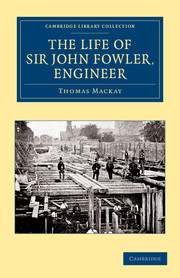Refine search
Actions for selected content:
26946 results in Economic history
Illustrations
-
- Book:
- The Merchant Republics
- Published online:
- 05 December 2014
- Print publication:
- 11 December 2014, pp xi-xi
-
- Chapter
- Export citation
8 - Capital Goods Imports, Machinery Investment and Economic Development in the Long Run: The Case of Chile
-
-
- Book:
- The Economies of Latin America
- Published by:
- Pickering & Chatto
- Published online:
- 05 December 2014, pp 119-130
-
- Chapter
- Export citation
List of Figures and Tables
-
- Book:
- The Economies of Latin America
- Published by:
- Pickering & Chatto
- Published online:
- 05 December 2014, pp ix-x
-
- Chapter
- Export citation
2 - Progress and Development
-
- Book:
- Energy, Trade and Finance in Asia
- Published by:
- Pickering & Chatto
- Published online:
- 05 December 2014, pp 33-50
-
- Chapter
- Export citation
4 - ‘Our Present Adventure’: India and Beyond
-
- Book:
- Entrepreneurial Families
- Published by:
- Pickering & Chatto
- Published online:
- 05 December 2014, pp 59-76
-
- Chapter
- Export citation
Index
-
- Book:
- Gambling on the American Dream
- Published by:
- Pickering & Chatto
- Published online:
- 05 December 2014, pp 309-319
-
- Chapter
- Export citation
1 - Historical Setting
- from Part I - The Subsoil in Brazilian History
-
- Book:
- Mining and the State in Brazilian Development
- Published by:
- Pickering & Chatto
- Published online:
- 05 December 2014, pp 9-18
-
- Chapter
- Export citation
7 - Gender and Migration in the Pyrenees in the Nineteenth Century: Gender-Differentiated Patterns and Destinies
-
-
- Book:
- Female Economic Strategies in the Modern World
- Published by:
- Pickering & Chatto
- Published online:
- 05 December 2014, pp 127-144
-
- Chapter
- Export citation
Index
-
- Book:
- Female Economic Strategies in the Modern World
- Published by:
- Pickering & Chatto
- Published online:
- 05 December 2014, pp 195-201
-
- Chapter
- Export citation
Index
-
- Book:
- Money in the Pre-Industrial World
- Published by:
- Pickering & Chatto
- Published online:
- 05 December 2014, pp 217-225
-
- Chapter
- Export citation
7 - Milton Friedman and the Arguments for Flexible versus Fixed Exchange Rates
-
- Book:
- Reforming the World Monetary System
- Published by:
- Pickering & Chatto
- Published online:
- 05 December 2014, pp 97-108
-
- Chapter
- Export citation
8 - Women and Property in Eighteenth-Century Austria: Separate Property, Usufruct and Ownership in Different Family Configurations
-
-
- Book:
- Female Economic Strategies in the Modern World
- Published by:
- Pickering & Chatto
- Published online:
- 05 December 2014, pp 145-160
-
- Chapter
- Export citation

Energy, Trade and Finance in Asia
- A Political and Economic Analysis
-
- Published by:
- Pickering & Chatto
- Published online:
- 05 December 2014
-
- Book
- Export citation

The Life of Sir John Fowler, Engineer
-
- Published online:
- 05 December 2014
- Print publication:
- 18 April 2013
- First published in:
- 1900
Index
-
- Book:
- Federal Banking in Brazil
- Published by:
- Pickering & Chatto
- Published online:
- 05 December 2014, pp 219-228
-
- Chapter
- Export citation
Frontmatter
-
- Book:
- Money in the Pre-Industrial World
- Published by:
- Pickering & Chatto
- Published online:
- 05 December 2014, pp i-vi
-
- Chapter
- Export citation
Acknowledgements
-
- Book:
- Reforming the World Monetary System
- Published by:
- Pickering & Chatto
- Published online:
- 05 December 2014, pp ix-x
-
- Chapter
- Export citation
CONTENTS
-
- Book:
- Multinationals, Subsidiaries and National Business Systems
- Published by:
- Pickering & Chatto
- Published online:
- 05 December 2014, pp v-vi
-
- Chapter
- Export citation
Acknowledgements
-
- Book:
- Entrepreneurial Families
- Published by:
- Pickering & Chatto
- Published online:
- 05 December 2014, pp vii-viii
-
- Chapter
- Export citation
List of Figures and Tables
-
- Book:
- Money in the Pre-Industrial World
- Published by:
- Pickering & Chatto
- Published online:
- 05 December 2014, pp ix-x
-
- Chapter
- Export citation
